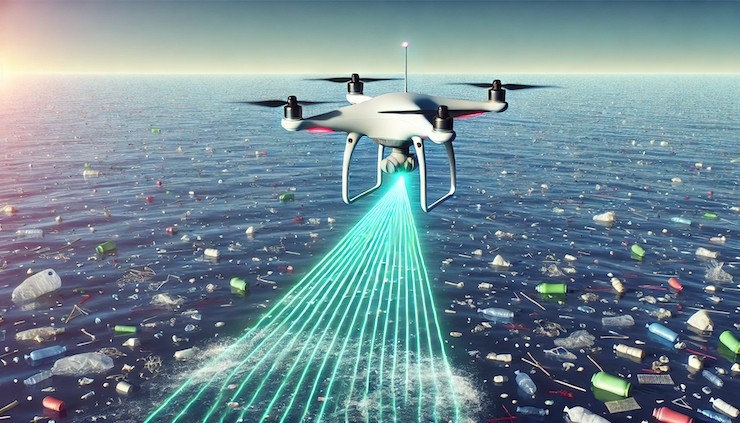Drone Powered Laser Tech for Detecting and Reducing Plastic Pollution in the Ocean

In 2008, Toshihiro Somekawa earned his Ph.D. in science from Osaka University. Upon graduating, he joined the team at the Institute for Laser Science at the University of Electro-Communications in Chōfu, Japan. The institute, which opened in 1980—the same year Toshihiro was born—is dedicated to the development of lasers that support the technologies the world depends on. To study within the laser institute, candidates must have a doctoral degree and be working toward novel laser development and implementation.
Toshihiro’s area of expertise is hyperspectral Raman imaging. Named after Indian physicist C.V. Raman, Raman spectroscopy is the practice of using lasers to determine the vibrational modes of molecules. Hyperspectral imaging takes what a laser scans and processes it into a map representing each pixel in an image that can be analyzed. Recently, Toshihiro and a team of research assistants published their findings on using hyperspectral Raman imaging to monitor plastic pollution in water systems.
An estimated 171 trillion pieces of plastic are clogging the world’s oceans, making it one of the biggest environmental threats to the planet. “To manage and protect the marine environment,” Toshihiro said, “it’s essential to assess the size, concentration, and distribution of plastic debris, but traditional lab-based methods are often time-consuming, labor-intensive, and expensive.” Toshihiro tasked his team with designing a laser system that could sustainably monitor plastic pollution and assist in the development of pollution mitigation plans.
Using laser technology to detect plastic pollution is not a new idea. Toshihiro and his team had previously built a Raman imaging system for this issue, but it was not suitable for use in aquatic settings. Other researchers have built lasers that can detect plastics in marine environments as well. However, as Toshihiro points out, these laser systems need to be close to the object for accurate detection. This is why Toshihiro came up with a plan to combine hyperspectral Raman imaging with drone-enabled LiDAR technology.
LiDAR, an acronym for Light Detection and Ranging, uses a laser to measure the time it takes for a scanned image to reflect back. It can be used in terrestrial and aerial applications and is often used to develop maps into 3D representations. Since drones are commonly used in surveying and mapping, LiDAR lasers have become regular features on these devices.
Toshihiro and his colleagues published their findings, titled Remote Detection and Identification of Plastics with Hyperspectral Raman Imaging LiDAR, in the 2025 Volume 50, Issue 1 edition of the scientific journal Optics Letters. In the paper, Toshihiro explains, “We designed our system to acquire images and spectroscopic measurements simultaneously. Since the Raman spectrum is unique for each plastic type, the imaging information can be used to understand the spatial distribution and type of plastic debris, and hyperspectral information can be obtained from targets at any distance due to the pulsed laser enabling range-resolved measurements.”
Additionally, Toshihiro and his team built the low-cost laser system to be light enough to fit on a drone. Experiments revealed that the drone’s hyperspectral Raman LiDAR device could detect plastic pollution from a distance of nearly 20 feet. This enables the device to have practical applications in marine or land environments. “The system could also be used for other monitoring applications, such as detecting hazardous gas leaks,” Toshihiro said of the drone.
Toshihiro Somekawa’s innovative work with hyperspectral Raman imaging, LiDAR, and drone technology not only advances our understanding of plastic pollution but also opens the door to more sustainable and efficient monitoring methods. By combining cutting-edge laser technology with drone capabilities, his team has developed a system that can help mitigate one of the planet’s most pressing environmental challenges. As their research continues to evolve, including testing the drone system in deeper waters, it holds promise for broader applications, potentially aiding in the protection of ecosystems and improving environmental management efforts worldwide.
|